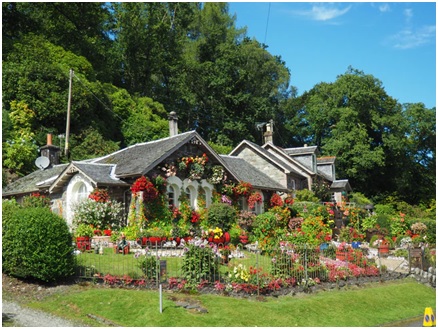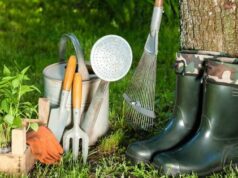The joy of gardening is well-known to those who invest their time in nurturing the flowers and vegetables inside their backyards. The satisfaction of watching flowers in bloom and ripen fruits and vegetables is highly beneficial.


Of course, a wonderful, thriving garden is a product of regular care and careful maintenance. A healthy garden doesn’t just happen on its own. The following is a detailed guide on how to create a garden from the very start, making sure it will thrive.
1. The right, healthy soil
The right soil means soil that’s fertile, loamy, permeable and of right pH. It also means organic soil, in contrast with chemically-treated soil.
Plants will be healthy only if they grow in nutrient-rich soil. Otherwise, they will be more prone to diseases and won’t produce well.
First, buy a soil test kit at the local garden center. You can test the level of specific nutrients and pH for only $20. The kit comes with instructions on how to improve the state of your soil once you’ve compared it to the soil your plants prefer.
2. Get healthy plants
The easiest way to prevent disease in your garden is by planting an already diseased plant. However, it’s very hard to learn how to recognize a diseased plant from a healthy one.
Start with collecting a few books on the subject. They show how a healthy plant should look like. In case you spot rotted stems, dead spots, or insects, don’t take that plant home.
You should also learn how to differ healthy roots from rotting ones. Few people do it in a garden center, which is a shame. Grab the plant gently by its stem, just above the soil. Slowly invert the pot and shake the plant – it will get loose a bit. If it doesn’t, tab the pot a few times. When you finally see the roots, perform the inspection. Healthy roots should be mostly white and firm, spaced over the whole root-ball. Avoid plants with dark or mushy roots.
Note that even a plant that has a healthy top part will die soon if its roots are rotten.
3. Proper spacing
Proper plant spacing is one of the essential factors in creating a healthy garden. It’s necessary to provide proper air circulation for every plant, while pot plants should be in pots large enough for their needs.
Low-growing plants and groundcovers should be grouped in tight beds. It will also reduce the need for weeding and water wasting. Moreover, it will be easier for you to maintain it.
On the other hand, leave enough space between the plants and the rows to enable air circulation. It also helps to repel fungal attacks. However, if your space is limited and you want the highest return possible, plant indeterminate tomatoes, zucchini, and pole beans in containers.
Still, watch out for plants placed tightly together. They could start fighting for nutrients, light, and water, making themselves susceptible to diseases. Sometimes an infected leaf spreads the disease to a healthy leaf just because they were next to each other.
4. Planting position
For every type of plant, you need to find a position with proper sunlight. Don’t forget some plants thrive in the shade, too.
The position you choose must also have good drainage. If your plants are inside containers, make sure there are enough drainage holes on the bottom of the containers.
Keep an eye on the plants that start to spread. If plants get too crowded, it can create perfect conditions for rust, powdery mildew, as well as downy mildew. Enable airflow whenever you notice it’s too crowded to allow foliage to dry more quickly. Whenever you notice a damaged part of a plant or a couple of crowded stems, trim them. You will prevent potential diseases. Whenever necessary, divide the stems or rearrange them.
5. Right watering
Right watering is very important – you need to be careful not to drown them in water. It could lead to the development of root-rooting fungi. Although every plant has specific needs when it comes to watering, neither one of them likes to be overwatered or underwatered.
The right watering time is in the morning when there’s no strong wind and sunshine. That way, a minimum amount of water will evaporate. If you water the plants in the evening, you risk leaving them damp overnight. Too much moisture inside the soil could lead to fungal and bacterial diseases. If the plants are established, water them infrequently but substantially.
You can also use soaker hoses and drip irrigation to limit the amount of moisture on the foliage. On the other hand, many gardeners water their plants by hand. If you do it, too, remove the leaves when you’re watering. Only the roots should be damp. Otherwise, it could lead to leaf problems. Still, if watering by hand is your method of choice, and you usually sprinkle over the plants, choose the right time. It should be the time of the day when the leaves will have the chance to dry.
6. Time for pruning
Late winter is the best period for pruning, especially if parts of the plant or the tree are damaged. Doing it in the spring brings some risks. Wounded limbs usually get infected during the winter, when the plant is dormant. Removing them before the season ends decrease the risk of a disease.
Of course, there can be storms during that period but it’s still a safer bet. Make sure you always use appropriate, sharp garden shears and other tools. Clean cuts will allow the wound to heal quickly if you make them to healthy tissue.
Pruning is also useful during summer, as it can delay bolting. If you frequently prune a vegetative crop, such as basil, lettuce, or dill, it will discourage the flowering process. By doing that, the plant’s energy will be put into sprouting new leaves. On the other hand, pruning the foliage of fruiting crops leads to increased fruit production.
7. Careful with mulch
You should always have some mulch at your disposal. Note that it isn’t the same as wood chips. Also, some bags labeled as mulch could be made from chemically colored wood products. It’s the truth with low-end mulches, which is ok if you use them for plants you don’t intend to it. However, you shouldn’t use them for your vegetable garden.
Instead, opt for natural, untreated mulch that brings only organic material to your garden. You can spread it around the plants to cover patches of bare ground, prevent the development of weed and some diseases, and help the soil keep its moisture.
8. Keep an eye on the bugs
Insects not only ruin the aesthetics of your plants but they can also bring some serious problems. Bugs often make openings on the plants, through which a virus or bacteria can enter. Aphids can spread many diseases from one plant to another, as well as thrips. Leafhoppers carry a disease called aster yellows, which can use many garden plants as its host.
In case your garden is being swarmed with slugs, use beer to fight them off. Keep a container filled with beer, and then let the soil drink it up overnight. The slugs will be attracted by the scent of beer, ending up in the container. Do it every night until all the slugs have disappeared.
9. Plants resistant to diseases
There are certain disease-resistant varieties of specific plants. Even if they get infected, they will be able to recuperate. For example, there’s a variety of tomato on the market coded as “VFN resistant”, meaning it’s resistant to Verticillium and Fusarium fungi, as well as to nematodes.
However, you’ll notice that few plants have these codes, which doesn’t mean they are not resistant to some diseases. For example, many rose companies offer rose varieties resistant to black spot and powdery mildew.
Ask for help from nursery employees and other gardeners to identify the most resistant varieties in every type of plant you wish to grow. Look up the information in reference books and catalogs, as they could have the info on disease-resistant varieties.
10. Use completely composted yard waste
If you are using a compost pile for your garden, make sure it’s been fully composted. Different materials decompose at different rates, which means only some materials inside the compost have degraded enough to be placed in the garden.
If you do thorough composting, it will increase the temperature over a longer course of time, killing pathogens in the compost in the process.
On the other hand, infected plant debris that hasn’t decomposed enough could spread the disease throughout the garden if you use the compost that has it too soon. If you are not sure about the condition of your compost, don’t use yard waste for sensitive plants and don’t avoid infected plant debris in the compost.
11. Staggered planting for frequent produce
In time, every plant will wilt and die. To prevent running out of its products and fruits, put successive or staggered planting into action. It means planting a round of replacement crops while the current crops are still giving fruits and growing. That way, you will have an uninterrupted cycle of fresh produce, and a garden that’s always thriving.
12. Support pollination
To get more abundant harvests, it’s important to support pollination. During summertime, you get to enjoy your garden the most, as there are numerous fruiting crops, including peppers, cucumbers, tomatoes, and eggplants. As long as they are pollinated, you will get to enjoy their different flavors.
If bees and butterflies are not doing their jobs, you can pollinate the plants manually. Another neat trick is growing a variety of flowering crops, which will make the garden more hospitable for the beneficial insects, too.
All in all
One of the aspects that make gardening so interesting and fulfilling are the challenges you face along. Every garden is a micro representation of natural life, which means you, as its owner, can’t affect everything that happens inside of it.
Of course, the tips you found here will give you a greater chance of creating a healthy, thriving garden. It’s always good to know you are doing everything you can for your garden – after all, that’s usually enough in most cases, and that’s what so great about gardening.









